célébrations de la clarinette
Page 1 sur 1
 célébrations de la clarinette
célébrations de la clarinette
CLAIR ET NET ?
ayant renoué avec mon premier instrument de musique, la clarinette en Bb - j'excepte le pipeau, le mirliton et l'harmonica. À vrai dire, mon père nous avait inscrits, mon frère et moi, à l'école municipale de musique parce qu'il n'avait pas trouvé les Scouts de France, je l'ai échappée belle. Le professeur, une grosse dame, me terrorisait, elle tapait sur les doigts des "mauvais", dont j'étais à ses oreilles. En fin d'année, il fallait choisir entre le piano, le violon, ou la clarinette, les premiers soi-disant réservés aux meilleurs élèves, mais de fait à ceux dont les parents pouvaient acquérir ou louer un piano ou un violon. Ma première clarinette fut donc de location, la seconde payée sur mon premier salaire, l'été de mes 16 ans, et ma première méthode la Klosé d'un cousin chef de "L'Indépendante", harmonie municipale de Saint-Germain-des-Fossés
ce sujet proposera quelques écoutes de morceaux que j'affectionne particulièrement. La clarinette m'a branché sur le jazz au milieu des années 60, via Sidney Bechet, Claude Luter, Acker Bilk... J'ai découvert par la suite ses précurseurs de la Nouvelle-Orléans puis dans le jazz moderne
au début des années 70, j'avais enregistré sur cassette une "histoire de la clarinette dans le jazz", sur la base de ma discothèque, qui ne contenait pas encore Buddy de Franco, Jimmy Giuffre, Eric Dolphy...
pour commencer, une considération technique, le choix du type de clarinette, dont on sait peu qu'il fut déterminant dans ses premières utilisations en jazzLe son perdu des clarinettes néo-orléanaises
Florian Royer, France Musique, 26 décembre 2017
Les clarinettistes néo-orléanais qui officiaient lors des premiers âges du jazz possédaient un son caractéristique, que les enregistrements acoustiques n'ont pas toujours su reproduire. Mais pourquoi ce son traditionnel a-t-il progressivement été abandonné à partir des années 1940 ?images et vidéos ajoutées
Johnny Dodds, l'un des plus éminents représentants du style néo-orléanais
Getty / Gilles Petard
Les clarinettistes néo-orléanais des premiers temps du jazz, du moins du jazz enregistré, parvenaient à donner une couleur particulière à leur musique. Ils produisaient un son semblable à « un gémissement », explique Michael G. White, chercheur à l'université Xavier, justement basée à la Nouvelle-Orléans. Lui-même clarinettiste, il s'est demandé à quoi était dû ce son si spécifique. La partie de clarinette de Barney Bigard dans Jackass Blues, enregistré par l'orchestre de King Oliver en 1926, est un bon exemple de ce son plaintif. Évidemment, les méthodes de fabrication et les matériaux ont changé, et ils ont un impact important sur le son, explique le chercheur. La taille, la forme générale et l'anche utilisée ont aussi leur importance dans l'affaire, mais ces éléments ne sont pas primordiaux. Jimmie Noone, Albert Nicholas et George Lewis avaient un secret que leurs cadets, nés hors de la cité du Croissant, n'avaient pas.
Johnny Dodds, 1926
, Barney Bigard, solo de clarinette à 2:08
Jimmy Noone, 1929
Artie Shaw, 1938
(ou le "privilège blanc")
Système Albert contre système Boehm (voir en ligne)
Selon Michael G. White, c'est le système Albert qui est à l'origine du son des clarinettes néo-orléanaises. Ce nom fait référence au positionnement des clés sur l'instrument. Ce positionnement a un impact sur le doigté. Il provient du système à 13 clés développé par Iwan Müller, au début du XIXème siècle. Il s'est répandu dans une partie de l'Europe et aux États-Unis. Un autre système est apparu vers le milieu du même siècle, il s'agit du système Boehm, conçu pour les flûtes.
systèmes Albert, et Boehm actuel
Grâce à un système d'anneaux, il facilite le jeu. « J'ai tenté de faire sonner des clarinette à système Boehm comme si elles étaient équipées du système Albert », a expliqué Michael G. White, mais le résultat n'a pas été concluant. « En revanche, j'ai fait plusieurs découvertes, notamment comment la position de la langue peut influer sur le flux d'air et sur la vitesse », a-t-il poursuivi. Le système Boehm s'est ensuite généralisé grâce à son jeu plus simple. C'est pourquoi Artie Shaw et Jimmy Giuffre ne possèdent pas un son comparable à leurs homologues de la Nouvelle-Orléans des années 1910-1920. Mais le son néo-orléanais est aussi dû en grande partie à l'apprentissage. Les jeunes Noone, Parenti et leurs camarades ont souvent eu les mêmes professeurs et admiré les mêmes modèles.
Un exemple de jeu de clarinette typiquement néo-orléanais :
comme au saxophone soprano, Syndney Bechet avait à la clarinette un son inimitable, autant qu'un nom prédestiné, Bechet étant celui d'une famille créole dont l'ascendance blanche était originaire de Savoie : bechet = petit bec...
Sidney Bechet, cl, Earl Hines, p, Baby Dodds, dr.
Recorded September 6, 1940.
hasard ou nécessité, la tessiture de la clarinette en Bb, 3 octaves et une sixte (sans le sur-aigu), est équivalente à celle de la guitare 8 cordes, une octave au-dessus. Elle est la plus étendue de celles des instruments à vent. La véritable naissance de l'instrument moderne date de 1690, grâce à Johann Christoph Denner, avec l'ajout d'un pavillon et de deux clés au chalumeau français, dont une clé de douzième (quinte redoublée) et non d'octave, comme les saxophones (source : Histoire de la clarinette). Une conséquence est que les doigtés de gammes sont différents d'une octave à l'autre
avec le système Boehm, la clarinette n'a subi que peu de modifications depuis le 19e siècle. Il est frappant de constater (et d'admirer) que la facture et l'esthétique appartiennent définitivement à ce siècle, pour des raisons technologiques et artisanales évidentes, qui demeurent le secret des grands facteurs de cet instrument
voici la clarinette que je me suis offert, un compromis entre instrument d'étude et instrument de concert, une Yamaha YCL 650
très amusant, sur cette vidéo commerciale, le bec est monté à l'envers !
Dernière édition par Florage le Lun 7 Sep - 11:43, édité 1 fois
Invité- Invité
 Re: célébrations de la clarinette
Re: célébrations de la clarinette
JIMMY JOUES FREE
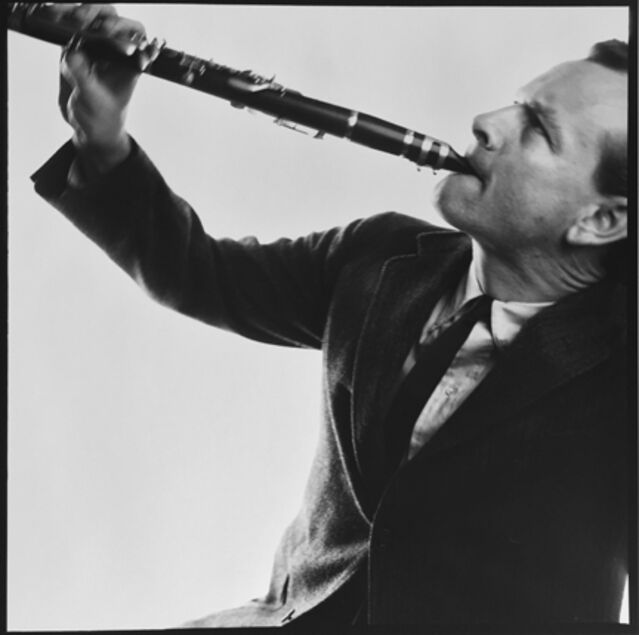
photo Bert Stern
Florian Royer explique plus haut la différence de son entre les clarinettistes de la Nouvelle-Orléans et les modernes par celles de systèmes Albert et Boehm. Il prend l'exemple d'Artie Shaw, dont j'ai donné une vidéo parfaitement éclairante, et de Jimmy Giuffre, ce qui est moins pertinentLe système Boehm s'est ensuite généralisé grâce à son jeu plus simple. C'est pourquoi Artie Shaw et Jimmy Giuffre ne possèdent pas un son comparable à leurs homologues de la Nouvelle-Orléans des années 1910-1920.
en effet, le son de Jimmy Giuffre est un choix esthétique redoublé du fait qu'il ne joue pratiquement que dans le registre grave et médium de la clarinette, c'est-à-dire sans utiliser la clé de douzième comme expliqué précédemment
j'ai ailleurs fait entendre Jimmy Giuffre, notamment en raison de sa collaboration, dans la seconde moitié des années 50 avec le guitariste Jim Hall et au début des années 60 avec le pianiste Paul Bley, à des trios avec contrebasse qui sont des chef-d'œuvre d'improvisation contrapunctique autant qu'une des sources historiques d'une des esthétiques du free-jazz (voir FROM BEBOP TO FREE-JAZZ, pré-révolutions du jazz dans les années 50
un disque de 1956 est indispensable pour qui veut connaître plus particulièrement son jeu à la clarinette en Bb, intitulé sobrement The Jimmy Giuffre ClarinetScott Yanow a écrit:This continually interesting set finds Jimmy Giuffre sticking exclusively to his cool-toned clarinet, mostly playing in the lower register, in several settings. The thought-provoking and generally relaxed works feature a wide variety of instrumentation. Giuffre takes "So Low" as an unaccompanied solo, duets with Jimmy Rowles' celeste on "Deep Purple," plays a fairly free "Fascinatin' Rhythm" in a Benny Goodman-type trio with pianist Rowles and drummer Shelly Manne, performs with a couple of other trios (including a group consisting of his clarinet, an alto clarinetist, and a bass clarinetist), uses three flutes and drums on the atonal "The Side Pipers" and three woodwinds plus bassist Ralph Pena on an atmospheric "My Funny Valentine," concluding with a nonet blues. A very interesting album, last available as a 1984All compositions by Jimmy Giuffre except as indicated
"So Low" - 2:48
"Deep Purple" (Peter DeRose, Mitchell Parish) - 4:38
"The Side Pipers" - 5:07
"My Funny Valentine" (Richard Rodgers, Lorenz Hart) - 5:03
"Quiet Cook" - 4:18
"The Sheepherder" - 5:23
"Fascinating Rhythm" (George Gershwin, Ira Gershwin) - 4:04
"Down Home" - 5:40
Recorded at Capitol Studios in Los Angeles, CA on March 21, 1956 (tracks 1, 4, 5 & 8 ) and March 22, 1956 (tracks 2, 3, 6 & 7)
Jimmy Giuffre - clarinet
Bud Shank - alto flute (track 3)
Buddy Collette - alto clarinet, flute (tracks 3 & 6)
Harry Klee - bass clarinet, bass flute (tracks 3 & 6)
Harry Edison, Shorty Rogers, Jack Sheldon - trumpet (track 8 )
Bob Cooper - tenor saxophone, oboe (tracks 4 & 8 )
Dave Pell - tenor saxophone, English horn (tracks 4 & 8 )
Marty Berman - baritone saxophone, bassoon (tracks 4 & 8 )
Jimmy Rowles - piano, celeste (tracks 2 & 7)
Ralph Peña - bass (tracks 4, 5 & 8 )
Stan Levey (tracks 5 & 8 ), Shelly Manne (tracks 3 & 7) - drums
solo intégral + tap foot
The Sheepherder,
avec Buddy Collette à la clarinette alto, et Harry Klee à la clarinette basse
autres morceaux
commentaires à chaque morceau par Jimmy Giuffre sur la pochette du LP 33t de 1956
je reviendrai avec les miens propres quand j'aurais mieux ré-écouté ce disque et expérimenté quelques passages ... à ma portée musicale
Invité- Invité
 Re: célébrations de la clarinette
Re: célébrations de la clarinette
SHABAKA
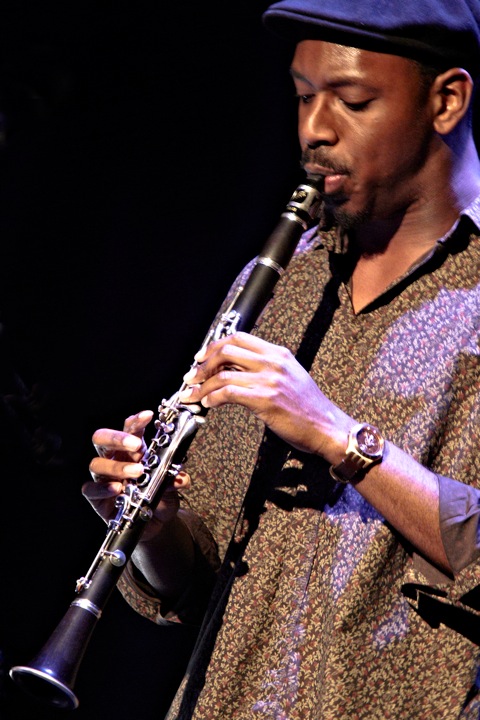
Shabaka Hutchings is a British-Barbadian jazz saxophonist, clarinetist and band leader. He leads the bands Sons of Kemet and Shabaka and the Ancestors
Soweto Kinch a écrit:@sowetokinch
Had a wide ranging and important conversation with
@shabakah @BecauseJyoty @arts_allies @realmusicrebels
White supremacy is woven into the music industry, jazz, the arts and capitalism. We all need to be free of it. Available this Sunday at #WeOutHereFest
SHABAKA HUTCHINGS & STOP THE WAR
PRESENT A COMPOSITION
IN MEMORY OF THE VICTIMS OF HIROSHIMA
Ben Verghese, August 11, 2020
Invité- Invité
 Re: célébrations de la clarinette
Re: célébrations de la clarinette
HIRONA DU SORT
le mot "clarinettiste" est du genre qu'en n'a pas, comme la mésange qui à l'instant pépie sur ma terrasse. Le "e" muet est l'amour de mes anges. Comme je n'ai parlé que de clarinettist'hommes, je dois me rattraper. Chose faite,monma professeurE sera unE clarinettistE. Et pour conserver les bonnes habitudes, une Japonaise, Irobe Hirona
de plus, elle a l'air parfaitement bilingue, ce qui, compte tenu de l'importance de la langue pour la clarinette, présente un double avantage, vu que mon peu de japonais fout le camp. Covid oblige, pour préserver la distanciation sociale, je ne mettrais pas la main sur ses anches. Vous rigolez, mais c'est un sacré problème de liaison, il faut sortir couvert et tout... !
Can singing and wind instruments be made safe during coronavirus?
Sharon Udasin, The Colorado Sun, Jul 30 2020
Invité- Invité
 Re: célébrations de la clarinette
Re: célébrations de la clarinette
PAQUITO D'RIVERA
« la clarinette est un instrument féminin, on ne sait jamais ce qu'elle pense »
In this interview done during the Jazz Cruise in 2016, saxophonist and clarinetist Paquito D’Rivera talks about the challenges and rewards of the clarinet.
In an archival interview from 2013, Anat Cohen talks about Cuba, Brazilian music and the clarinet with her fellow virtuoso clarinetist and saxophonist
extraits
AC: I have so many questions for you. People ask me this question about the clarinet and the saxophone. It’s like, who do you like more, Mom or Dad? How does it work for you?
PR: You know, I tried to stop playing the saxophone and play only the clarinet. It was impossible. I cannot do it. I tried. I said, let’s dedicate myself to the clarinet. The clarinet is a very demanding instrument. It’s a pain in the neck. Now, always I say that it’s a female instrument, the clarinet, because you never know what she’s thinking [laughs]. And Frank Wess said something very funny, only because he hates the clarinet, and he said that the clarinet was invented by five men that never met. [laughs]. It’s totally unpredictable. You blow in and sound perfect, you leave it there and it’s totally [expletive], when you pick it up it’s aaagggh! You know the feeling, right? The saxophone, you leave it in the case for years, and then you pick it up and it sounds pretty horrible, but at least you can get some sound out of it and five minutes it’s sounding like, you know… maybe you’re not sounding like, Coltrane, but, at least with a sound. Not with the clarinet. And sometimes it starts sounding beautiful, three minutes later, aagggh. It’s very easy to make it sound horrible, that instrument. But when it sounds good it’s amazing, eh?
AC: It’s amazing. It’s the most beautiful instrument.
PR: And it’s very, very few of us…we are the clarinet group, but the clarinet mafia. It’s elite. So, we are very picky with the sound of people. And we immediately know when somebody’s going to play good the clarinet just to pick it up. People that don’t, we say, “Uh-uh, that guy don’t play the clarinet.” Sometimes they try to get hip, you know, try to blow it like a saxophone. That is not the saxophone.
AC: That’s when you get the surprise coming out. SQEEEEK!
PR: Yeah, the surprise coming out. You know what Phil Woods told me? He said, “The clarinet squeaks in the case, man.” [laughs]
AC: I can relate.
PR: I said, “Where is your clarinet?” He said, “My clarinet is a lamp.”
AC: Is a lamp?
PR: Is a lamp. [laughs]
AC: That’s fantastic…So Benny Goodman was one of the first jazz clarinetists that you heard.
PR: Yeah.
[...]
Audience Member: Do you feel like playing the clarinet is trying to keep alive something that is potentially dying in jazz?
PR: Well, that is growing. There are more people. There are very few of us. But, thanks to people like Anat, the clarinet is picking up again. For many since the rediscovery of the soprano saxophone, it’s easier…it’s a lot easier. Even the soprano is a little harder to play in tune, like the tenor or the alto. It’s a lot more simple for the saxophone player not to learn other instruments like the clarinet… and that’s why for many years, they stop playing. And, I don’t know, for 50 years or something, or maybe 60, the only clarinet player around was Buddy DeFranco and, I don’t know, Jimmy Giuffre-three or four people. But, in order to play the clarinet you need the passion for that instrument. You need the passion to look for a good reed, for a nice sound, and you don’t have to think as a doubler. What happened is that the clarinet had been neglected for so many years that when the saxophone players pick it up it sounds so horrible, and they think that doesn’t matter. It matters. It matters because the sound… that is why many people say the clarinet sounds horrible, that’s why we don’t play. No, the clarinet don’t sound horrible. Those people are making the clarinet sound horrible and that’s why people think the clarinet sounds horrible. But when you hear to Ken Peplowski playing the clarinet, you don’t think it sounds horrible. And when Eddie Daniels plays the clarinet you feel like killing yourself. You know. Because it sounds so beautiful. I think that the clarinet is coming back thanks for people like that. Well it’s not an easy task. Another problem with the clarinet is the volume. The excess volume that we have been accustomed to has neglected the clarinet great a great deal because you can put a big mouthpiece in the saxophone and it takes off-wehhhhhhhh! And then you sound like Van Halen with the saxophone, but you cannot do that with the clarinet because it sounds absolutely pathetic.
Invité- Invité
 Re: célébrations de la clarinette
Re: célébrations de la clarinette
retour sur les clarinettes des débuts du Jazz à New-Orleans. En ouverture de ce sujet, j'ai publié Le son perdu des clarinettes néo-orléanaises, Florian Royer, France Musique, 26 décembre 2017 : « Les clarinettistes néo-orléanais qui officiaient lors des premiers âges du jazz possédaient un son caractéristique, que les enregistrements acoustiques n'ont pas toujours su reproduire. Mais pourquoi ce son traditionnel a-t-il progressivement été abandonné à partir des années 1940 ? »
j'ai eu quelques doutes à l'écoute de clarinettistes de la New-Orleans jouant sur système Boehm et qui semblaient n'avoir aucun des problèmes de l'auteur de cet article pour produire les sons caractéristiques de cette période, au demeurant assez divers et reconnaissables de l'un à l'autre. Dans la vidéo sous l'article le clarinettiste Evan Christopher montre comment produire les Blues Inflections in New Orleans Jazz, sur système Boehm, avec anneaux donc au-dessus des trous
l'article ci-dessous est très intéressant. Je souscris à l'idée que le son de Sidney Bechet à la clarinette lui vient directement de Johnny Dodds et que sa technique (sans les dents sur le bec) a directement inspiré son approche du saxophone (soprano) dont il fut dans le Jazz le premier inventeur, influençant par son style notamment Johnny Hodges (alto) et Coleman Hawkins (ténor), ceci dans sa première période d'activité au début des années 20, avant son retour dans les années 1935-40 et son arrivée en France après guerre. Toujours est-il que je ne connais pas sur la clarinette de son aussi gros, épais, dur, dans le chalumeau que celui de Dodds puis Bechet (Blues in Third, vidéo plus haut)
Johnny Dodds: His Teachers and Clarinets
Christopher D. K. Cook, The Syncopated Times, Explored the World of Hot Jazz, Ragtime, and Swing, May 10, 2020
vidéo ajoutée
Christopher D. K. Cook, The Syncopated Times, Explored the World of Hot Jazz, Ragtime, and Swing, May 10, 2020
vidéo ajoutée
Christopher D. K. Cook played clarinet with several revivalist groups during the 1960s in Edinburgh, Derby, Cambridge, Munich (Germany) and finally Liverpool. He lives in Switzerland where he spent his professional career as a noted botanist and researcher.
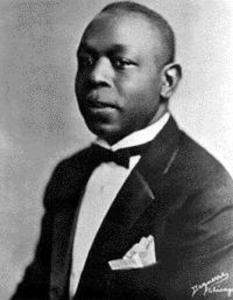
Clarinetist Johnny Dodds
Much has been written about Johnny Dodds. Unfortunately the biography by Lambert (1961) that inspires much of it is not well-researched and is mostly a personal appreciation of some of his recordings.
The discography by Dürr (2000), is not only a discography of all known 78 RPM records, but has an excellent bibliography and the last pages have important biographical information, reprints of letters and an interview with Johnny Dodds’ eldest son. Example: Johnny Dodds’ “sex education” of his two son’s was putting a revolver to his eldest son’s temple and saying “If you ever ruin the life of another man’s daughter – I don’t care how ugly she is, how short her hair or how skinny her legs – I’ll blow your brains out”.
The Solo Style Of Johnny Dodds by the late Patricia A, Martin (2003) is an essential publication which is well-researched and has an excellent bibliography. She avoids making value judgements. There are, unfortunately, rather a lot of mistakes – wrong dates, wrong personnel and many other trivia.
Johnny Dodds was born on 12 April 1892 in uptown New Orleans. His father was a warehouse employee. He had two elder sisters and one elder brother, his younger brother Warren ‘Baby’ Dodds was born on 12 December 1894; he became a skillful drummer. In about 1901, the family moved to a farm in Waveland, Mississippi. The two sons went to school in Bay St Louis a few miles east of Waveland. In May 1904, Dodds’ mother died. The family lived with the father who gave Johnny his first clarinet in 1908 – he previously played tin whistle. He was taught the rudiments of the instrument in Bay St Louis. In 1940, he told Bill Russell that after five lessons he knew more than his teacher.
According to Joe Robichaux (piano player, band leader and nephew of Johnny Dodds), in ca. 1914, he together with Johnny Dodds took music lessons with Dave Perkins (cited by Vernhettes & Lindström. 2019). Presumably to improve his reading.
Dave Perkins (ca. 1872 to 1926), quoting Jack ‘Papa’ Laine, was a Mulatto and acquired a first-class musical education and later, taught music of all origins from about the 1890s. He played with white and colored bands. According to his cousin Pops Forster, he became president of the White Musicians Union in New Orleans.
Apart from Johnny Dodds and Jack Laine he also taught the trombonist Morris French and, according to Stella, Joe ‘King’ Oliver’s wife, he also taught Joe Oliver. Aside from teaching, he played in numerous bands. In 1918, he played trombone in Manuel Perez’s Creole Jazz Band and in the early 1920s his own band played on the Streckfus Steamer Capitol. Dave Perkins married a white woman. Laine was racist and did not approve of ‘nigger’ bands. Although Laine knew Perkins was a Mulatto, he never disavowed him.
Fig. 1. The Reliance Brass Band in 1906. Standing: Dave Perkins, Vincent Barocco, Sidney Moore, Pete Pellegrini, Freddy Neuroth, Jack Laine. Seated: Manuel Belasco and Joe Alexander.
Later, about 1919, Johnny Dodds studied under Charles McCurdy in New Orleans. Also, according to Russell, Dodds listened to Big Eye Louis Nelson, Alphonse Picou, George Bacquet, and Lorenzo Tio Jr. In 1940, he told Charles E. Smith that Sidney Bechet was the first person to influence him. From Bechet, he adopted the double embouchure (both lips between teeth and mouthpiece), which, incidentally, Benny Goodman adopted after lessons from Reginald Kell, the famous British concert clarinetist who moved to the USA.
In 1909, Johnny Dodds moved to New Orleans and got a job at the Empire Rice Mills. Apparently, he practiced during the lunch break and in 1911/12 was discovered by Pops Forster. By 1912, he was a full-time musician in Kid Ory’s Creole Ragtime Band in New Orleans. From then onwards, he was a professional musician until his death. Stories about him driving a taxi are unfounded.
A short biography of Charles McCurdy has been published in Vernhettes & Lindstöm p.19, 20 (2012). He was a New Orleans native, born in 1872 and died about 1937. He joined John Robichaux’s Orchestra at the turn of the century after being trained by Professor Lorenzo Tio Sr. According to Peter Bocage, interviewed in 1959, “Charlie McCurdy was a crack musician who played three clarinets (Bb, C, A) in the Robichaux band and played the C clarinet in parades with the Excelsior Brass Band”. I guess by “C” clarinet, “Eb” clarinet is meant.
About 1904, he was photographed in John Robichaux’s Orchestra, he is holding a Bb rather ancient, Albert or Simple System (Müller type) instrument with 13 keys, two rings, two trill keys and no rollers and in his lap, are similar instruments in A and Eb. This kind of instrument, an Albert clarinet from 1877 is shown on the photo Fig. 4. Albert and other makers were making more complex, thus easier to play, instruments in 1858.
Fig. 2. In a photograph taken on 24 May 1906 of Bob Frank and Charlie McCurdy’s Peerless Orchestra, McCurdy has a Bb instrument in his hand and has A and an Eb clarinets in his lap. He still has simple Albert system (Müller style), 13 key, two-ringed instruments. On his left Gilbert Frank has a flute on his lap and a piccolo in his hand; they are both ancient, wooden, simple system instruments with open holes and very few keys. See photo below (Fig. 3).
Barney Bigard told Barry Martyn: “Charlie McCurdy was quite a musician, but he wasn’t a jazz player, because he couldn’t improvise at all”. Big Eye Delisle told Robert Goffin that McCurdy played with Buddy Bolden in Henry Peyton’s band in 1900 – this seems rather strange. Ed Garland said he was the first in New Orleans to play all clarinet parts on his Bb clarinet, including those in A – this is most unlikely, particularly as Albert instruments do not reach down to Eb, or had he gotten a Full Oehler instrument or maybe converted to Full Boehm instrument?
THE JAZZERS’ CLARINET: A VERY MUCH SHORTEND HISTORY AND SOME SEMANTIC PROBLEMS
In 1840, Eugène Albert from Brussels patented a clarinet which became known as the Albert System clarinet.
In 1844, Hyacinthe Klosé and Auguste Buffet patented a different clarinet fingering system called ‘clarinette à anneaux mobiles’ which later became known as the Boehm clarinet. Compared to the original Albert, the Boehm system positions holes and keys for comfort, and eliminated cross-fingerings, while at the same time making the instrument more stable and more in tune. The system is like that of the saxophone and flute (the Boehm oboe and bassoon never caught on). The plain Boehm has 24 tone-holes, governed by 17 keys and 6 rings. It was a remarkable development because since 1840 it has hardly changed. Today it is by far the most popular kind of clarinet.
The original Albert clarinet had 21 tone holes 13 of which have pads, 13 keys or levers, 2 rings, both on the lower joint. The A and G# throat keys are not crossed and it had no rollers. This instrument became very popular particularly in military and other marching bands (in Britain it is usually called the Simple System). I have seen this kind of clarinet and heard it being played in the Balkans and in India where it is still being made. My very first clarinet, inherited from an aunt, was an original Albert in A.
In Europe and perhaps elsewhere, many of these clarinets were made for marching bands which used the old high pitch A4 = 452.5 Hz, or sometimes even higher; some military bands used A4 = 457 Hz. Many ‘jazz purists’ believing they have bought a treasure become disappointed because they cannot be played in the present concert pitch which is A4 = 440 Hz. Unlike some string instruments and some wines, clarinets do not improve with age.
Fig.4. An Albert clarinet in Bb made by Eugene Albert in Brussels in about 1877 (from Shackleton Collection).
By the 1920s, this original Albert clarinet was not the instrument played by the New Orleans and other early jazz clarinettists. For more serious work, two extra keys were added to the original Albert: a short side key for Eb and a long trill-key A-Bb, also the G# key is crossed over the A key (all copied from the Boehm system) and rollers were mounted on the G# and F keys (this helps the right little finger) and the E and F# keys for the left little finger.
The intonation and tone of the improved Albert instrument is very fine – it has, many people think, never been surpassed. This instrument is, however, difficult to play because the fingers (particularly the right hand) are widely spaced and there are few keys which means few alternative fingerings for most notes. The development of the Albert continued, and more and more rings were added – this brings the fingers closer together but meaning more holes. More keys were added to give alternative fingering which also means more holes. More holes mean great care is needed to keep the instrument in tune. The climax of this development is the Oehler (sometimes spelled Öhler) system
Many musicians who play the Oehler System are convinced that the tone and pitch are better than on a Boehm instrument but because of the greater amount of mechanism required, the technique is more complicated. The standard Oehler clarinet has 22 keys, four more, it may be noted than the Boehm (the full Oehler has 27 keys) and 6 rings, 4 rollers and up to 15 adjusting screws – it is not a simple clarinet and it is not cheap. Also, it is usually rather heavy.
Simpler models were made with 16 to 20 keys and four, five or six rings. These clarinets are and have been marketed under different names: German (Deutches) System is the most common today, Simple System in Britain and ‘Improved Albert’ in USA. This kind of instrument was used by most early jazzers.
JOHNNY DODDS’ CLARINETS
Several earlier authors have stated that Johnny Dodds could not read music. This is untrue. He could read and according to his brother he spent a fortune on sheet music and occasionally even transposed violin parts for the clarinet.
Dodds used the double embouchure (upper and lower lips over the mouthpiece) and a hard to very hard reed. This enabled him to play very loud and develop a very rich tone in the chalumeau and clarion ranges. The disadvantage is that most notes must be tongued (played staccato) which prevents the use of legato. Sidney Bechet, who Dodds considered to have influenced his playing, also had the same restriction.
Many great clarinettists from New Orleans, such as Jimmy Noone, Barney Bigard, Omer Simeon, Albert Nicholas, were taught by Lorenzo Tio Junior who insisted on soft reeds which allowed these players to develop great legato styles (staccato presents no difficulties) and to play in the altissimo range. None of them, however, had the power and volume of Bechet or Dodds.
Dodds was not a great clarinet technician. Mostly, he played in chalumeau (low register) or clarion (claret, clarinet, upper register). He tended to avoid the throat register (from G’ to Bb’ – the range in between chalumeau and clarion – “the dreaded break”). He also rarely used the high altissimo range (above Bb’’) and when he did he probably used his thumb and trill keys with excellent lip control to be in tune rather than using the normal rather complex fork-fingering. His magnificent tone and lip vibrato in both chalumeau and clarion range is difficult to copy.
Patricia Martin (2003) on page 36 writes: “Dodds was known to use a very basic thirteen-key, Selmer model Albert system for most of his career”. This is not substantiated by photographic evidence.
Some very good photographs were taken of King Oliver’s Creole Band in 1922. They clearly show that Dodds had a matched pair of clarinets; presumably an A and a Bb. They were top models. Both of his instruments have 6 rings, 15 keys, 4 rollers and a G# key for the little finger of the left hand. The A clarinet (standing by the piano) shows the cap for the C#4/G#5 key opening on the upper side of the lower joint just above the ring for first finger right hand, see Fig.6.
Fig. 5. The earliest photograph of Johnny Dodds’ clarinets which I have found is with Fate Marable’s Orchestra on the steamer Sidney taken in May 1919. He has a matched pair: a Bb in his hands and one in A on the floor by his feet. These instruments had only two rings and resemble the Albert instrument pictured on Fig. 4, except they seem to have rollers. Incidentally, according to Pops Forster, this was posed photograph and Sam Dutrey Sr., the band’s clarinet player, was ‘indisposed’ probably drunk so Johnny Dodds, who did not play with the band at this time, posed for the photograph – he is wearing an outdoor suit with waistcoat (vest) and a normal tie, the rest have tuxedos with bow ties. He does not look happy.
Eberhart Kraut (ca. 2002) wrote an article “Henri Selmer Klarinetten der 1920/30er Jahre” which makes it almost certain that in 1921, Dodds was playing an early Selmer “improved” Albert system instrument with the cup of the E valve on the left-hand side and the key for C#4/G#5 articulated and opening on the upper side of the lower joint just above the ring for first finger right hand. At this time, this instrument was also played by Omer Simeon and Irving Fazola. This model was also used as a template for the huge picture on the façade of the Holiday hotel in New Orleans.
Fig. 6. This a picture of a Selmer Improved Albert System clarinet (K-series) in Bb as played by Johnny Dodds in 1922 and 1926/27 (from E. Kraut).
The American makers Penzel & Müller and Meinl were also making instruments like this, Jimmy Dorsey, even in later years, played a simple Albert system instrument. Eddie Miller played a similar instrument which he bought from Jimmy Dorsey; after the Bob Crosby days, Miller changed to the Boehm system.
In pictures from 1926 or 1927 with the Hot Five (Armstrong holds a trumpet), Johnny Dodds seems to be playing the same instrument pictured in 1922 he also has an alto saxophone pictured lying on the piano in one picture and on the floor in another. The Selmer trademark is not visible on any photos of Dodds’ clarinets.
vidéo ajoutée
In 1939, Dodds was given a clarinet by Hoyte Kline. In his ‘thank you’ letter Dodds says “It is half Albert and half Boehm”. The upper joint of the Boehm looks rather like the Improved Albert/German System. The photo of this instrument by Ed Lawless, courtesy of John Dodds Jr., is rather poor (see Klatzko 1997, Dürr 2000) but it is certainly a Boehm. It is not the instrument Dodds was pictured playing in 1940.
In 1940, he is photographed in profile from both sides playing an instrument which was probably the top model Selmer because the cup of the E key is on the right side – three cups in line on the right side, see Fig.7. This is the model preferred by many New Orleans clarinetists such as Jimmy Noone, Barney Bigard, Irving Fazola and many others.
Fig. 7. This a picture of a Selmer Improved Albert System (L-series) clarinet in Bb as played by Johnny Dodds in 1940 (from E. Kraut).
The Uebel ‘636’ series also had three cups in a row on the right-hand side, but it was apparently not a great success and not many were produced. I do not know if this model was ever sold in the USA.
The clarinet in A is rarely seen in jazz and dance bands but is essential for ‘classical’ clarinetists. Dodds probably used this instrument to play in the key of G and perhaps sometimes also for Ab and C; other keys suitable for the A clarinet such as A and D are rarely used in jazz. Edmond Hall, also an Albert System player, used an A clarinet on occasion. In the early 1920s, Arnett Nelson is pictured with both A and Bb instruments.
The kind of clarinet that Dodds used in the 1920s is still being made today but is usually marketed as a German (Deutsches) System. It is unclear why the name Albert has disappeared from the catalogs, and why these clarinets are apparently not sold in the USA. They are being made by the following instrument makers (this list is probably incomplete and perhaps partly out of date):Oscar Adler: now taken over by Gebrüder Mönnig but German system clarinets are sold under the label Oskar Adler. They are made in Markneukirchen, Germany.
Amati – Denaki: made in Kraslice, Czech Republic.
Edelholz & M & N clarinets: made in Stadt Haag, Austria.
Hammerschmidt: made in Burgau, Germany – played by Edmond Hall and Evan Christopher (before Selmer).
Harald Hueyng: hand made to order in Düsseldorf, Germany.
Jupiter: made in Taiwan under German management.
Leitner & Kraus: hand made to order in Neustadt an der Aisch, Germany.
Clemens Meinel, now Rolf Meinel: hand made to order in Wernitzgrün, Germany.
W. O. Nuernberger (Nürnberger): hand made to order in Markneukirchen, Germany. This firm has nothing to with clarinets labelled: “William Nuernberger, American Artist” – they were made by Gebrüder Mönnig, Markneukirchen.
Herbert Neureiter: hand made in Söll, Austria.
Prof. Romero Orsi, Tradate, Italy: hand made to order; they will even make plateau models or metal clarinets – perhaps the last maker of metal clarinets.
Schreiber & Keilworth: they have recently been bought by Buffet – German system clarinets sold under the name Schreiber.
Schwenk & Seggelke: hand made to order in Bamberg, Germany – played by Dr Michael White.
F. Arthur Uebel made or ‘finished’ in Marktneukirchen, Germany – played by me (after 1963, Uebel instruments were mass produced and just ‘finished’ in Germany – secondhand buyers should choose numbers below 17,800). Their instruments of today are acceptable.
Wurlitzer: made to order in Germany. On their American website, Wurlitzer only offers its special reform Boehm clarinets.
Yamaha: made in Japan?
There are some cheap brands that might or might not be playable, most are of Chinese origin: Roy Benson, Eastman, Emerson, Karl Glaser, HSR, Mc Brown, Miwazaki, Palatino, Steinbach, Swing, Thomann, Tim Hendson, T. Tsunami, Tuyama and probably some others – do not buy any of these before trying them out. Today, some of the Buffet Group and Conn-Selmer instruments are also made in China.
Martin (2003), on page 34 writes: “Photographs of jazz bands and other musical groups show no evidence of a Boehm-system clarinet until about 1928”. This is not the case. In 1914 Arnett Nelson was playing a Boehm and received a Full-Boehm instrument from C. G. Conn.
The earliest photographs of Boehm clarinets in jazz bands that I have found are: Rudy Wiedoeft appears to have one in 1917 with the Frisco Jazz Band. In 1921, Don Redman with Fletcher Henderson; Don Pasquall with Vassar’s Scale Steppers. In 1922/3, Arnett Nelson with Jimmy Wade, still using a Full-Boehm model, Volly De Faut with the Sig Meyer Band. In 1923, Buster Bailey with Fletcher Henderson, Bill E. Schmidt with The Peacock Orchestra, Joe E. Poston & Robert Shelby with Cook and his Dreamland Orchestra, Irving Fazola in Louis Prima’s Kid’s Band. In 1924, Buster Bailey with Joe ‘King’ Oliver and with Fletcher Henderson. 1925 Eddie Cherie with Manuel Perez, Willie Lewis with Sam Wooding’s Club Alabam Orchestra, Don Murray and Fud Livingston. 1926 Volly De Faut (also pictured with a Full-Boehm model) and Danny Polo. There are photographs of other unnamed pre-1928 clarinetists in the bands of Erskine Tate and Willie Hightower.
Irving Fazola, in later years played a Selmer Improved Albert clarinet (Fig. 7), but in ca. 1923 he is pictured at the age of 13 in Louis Prima’s Kids’ Band (Driggs & Lewine, 1982). On the floor in front of the musicians are four saxophones (2 sopranos, 1 alto and 1 tenor) and a solitary Boehm clarinet. In 1930 with the Prima-Sharkey Orchestra, he is pictured holding an alto saxophone and possibly a Boehm clarinet at his feet (the photograph is not very clear); Nino Piconi with tenor and an unnamed alto player also have Boehm clarinets at their feet. Luke Schiro, cited by Chilton (1983) states that for a brief period Fazola started to learn Boehm system with Jean Paquay in New Orleans but then studied Albert system with Professor Guiffe. I suspect that Schiro got his dates wrong because he states that Fazola began playing “around 1928”.
IMPROVED ALBERT/OEHLER/GERMAN/SIMPLE OR BOEHM: WHICH IS BEST?
Today, musicians who play the Abert/Oehler system often spend time praising its tone and saying how good it is; Boehm players cannot see what the fuss is all about.
Compared to the Albert/German/Oehler, the Boehm has lots of positive features:
1. it is easier to play – it was designed for human fingers and it eliminates cross-fingerings.
2. it is standardized – nearly all Boehm instruments are much alike.
3. it is easy to manufacture and can be made cheaply – one can buy expensive ones.
4. it is relatively robust
Disadvantages of the Improved Albert/Oehler/German/Simple
1. it is difficult to play – the fingers are far apart, particularly the right hand, and either there are not enough or too many alternative fingerings.
2. it is not standardized – today it is made in versions with 18 to 27 keys with 2, 4, 5 or 6 rings.
3. it is difficult to manufacture and is expensive. (beware of newly made cheap ones)
4. it is fragile – it has some long levers and several adjusting screws.
The only professional New Orleans jazz clarinetist I have found who has converted from Boehm to Albert/Oehler/German/Simple system is Irving Fazola but there are several who have converted from Albert to Boehm:
Albert Nicholas switched because of the instrument’s fragility – his Improved Albert Selmer broke down in Egypt and had to be sent to France for repair. By the time he got it back he had adapted himself to the Boehm and stayed with it.
Eddie Miller – in his own words: “I had to change to Boehm (pronounced Bay-em in New Orleans) system, because even the third clarinet parts contained fingering that was just too fast for my old clarinet” Before he converted he played an Albert clarinet that he got from Jimmy Dorsey in the mid-1920s.
Other New Orleans clarinetists who changed from Albert to Boehm are Joe Darensbourg and Tony Parenti.
The claim that the tone is better than the Boehm will not withstand blindfold tests. Classically trained clarinetists try to sound alike while jazz clarinetists like to sound individually different. One may identify the player but not the instrument that is being played. In blindfold test of classic (for want of a better name)clarinetists, the jury was not able to distinguish Boehm players from German system ones except for one musician; they were all convinced that Sharon Kam played German system – she, in fact plays a Boehm!
It is the player’s mouth (embouchure) is responsible for the tone. This was brought home to me at a party; I heard Albert Nicholas play Sandy Brown’s clarinet. When Nicholas played it sounded like Nicholas when Brown played it sounded like Brown (rather close to Dodds and miles away from Nicholas, incidentally Brown played without his teeth using a wooden mouthpiece, but this did not faze Nicholas).
George Lewis certainly played many different kinds of ‘Albert’ clarinet from simple to complex – by just listening it is not possible to distinguish them; for a while he played an instrument that belonged to Jimmy Noone – this did not make him sound like Noone. Woody Allen demonstrates that not all Albert clarinets produce a good tone. Theoretically, the Albert/German/Oehler clarinet should have a special kind of mouthpiece unlike the French or Boehm kind. Pete Fountain (Boehm) inherited Irving Fazola’s (Improved Albert) mouthpiece; Fountain found it wonderful, but can any outsider tell the difference?
HAS THE ALBERT/GERMAN/OEHLER A FUTURE?
In Germany, Austria and some other eastern European countries most classically trained clarinetists play the Oehler system in spite of its disadvantages. I believe the reason is simple. The older and most respected teachers play the Oehler because their teachers used this system and students of today get jobs through recommendation from their teacher – quite simple really.
Musicians who today play in the manner of jazz clarinetists from the 1920s or 1930s, appreciate later clarinet players from New Orleans and like to follow in the footsteps of their mentors. There are today skilled jazz musicians playing Albert system instruments, for instance, Evan Christopher and Mattheus Seuffert (both Selmer Improved Albert (L-series or occasionally K-series), Dr Michael White and Wolfgang ‘Muffel’ Weth (both Full Oehler).
BIBLIOGRAPHYBriggs, Frank & Lewine, Harris. Black Beauty, White Heat. William Morrow & Co. Inc., New York 1-360 (1982).
Chilton, John. Stomp Off Let’s Go. Jazz Book Service, London 1-248 (1983)
Dürr, Klaus-Uwe. The Recordings of Johnny Dodds. Privately published by Klaus-Uwe Dürr, Hamburg 1-39 (2000).
Klatzko, Bernhard. The most complete biography of Johnny Dodds, 78 Quarterly No. 1 (Vol. 1, No. 10): 77-101 undated (written 1997, publ. ca 1999).
Kraut, Eberhart. Henri Selmer Klarinetten der 1920/30er Jahre. Sonic – Magazin für Holz- und Blechinstrumente, PNP-Verlag, 92318, Neumarkt, Germany Vol: 3: 10 unnumbered pages, undated (ca. 2003).
Lambert, G. E. Johnny Dodds. (Kings of Jazz Series). Cassell & Co. Ltd., London 1-90 (19619.
Martin, Patricia A. The Solo Style of Jazz Clarinetist Johnny Dodds: 1923-1938. i-vii, 1-142 (2003). A Monograph submitted to the Graduate Faculty of the Louisiana State University and Agricultural and Mechanical College in partial fulfillment for the degree of Doctor of Musical Arts. Available as PDF: http://etd.lsu.edu/docs/available/etd-0118103-203326/unrestricted/Martin_dis.pdf This is an essential publication which is well researched and has a very good bibliography. She avoids making value judgements. There are, unfortunately, rather a lot of mistakes – wrong dates, wrong personnel and many other trivia.
Vernhettes, Dan & Lindstöm, Bo. Jazz Puzzles Volume 1. Jazz‘ Edit. (www.JazzEdit.org) 1-140 (2012).
Vernhettes, Dan & Lindstöm, Bo. Jazz Puzzles Volume 3. Jazz‘ Edit. (www.JazzEdit.org) 1-212 (2019).

King Oliver's Creole Jazz Band in Chicago, ca. 1923. From left to right:
Honore Dutrey, Baby Dodds, Joe Oliver, Louis Armstrong (kneeling), Lil Hardin, Bill Johnson, and Johnny Dodds.
Photograph courtesy of the William Ransom Hogan Jazz Archive, Tulane University Library.
Invité- Invité
 Re: célébrations de la clarinette
Re: célébrations de la clarinette
un grand faible pour ce clarinettiste qui marqua, avec Duke Ellington dans les années 20, le style Jungle. Il quitte l'orchestre en 1942 et s'embarque dans la vague du New Orleans Revival, mais à l'époque par ceux qui en étaient les inventeurs. Sans doute celui qui marie avec le plus d'élégance la clarinette créole des débuts du jazz et la maîtrise technique, avec une superbe sonorité, moelleux des graves et médiums, tranchant des aigus. Un sens inné du blues... Dans L'écume des jours, Boris Vian parle des « perles aériennes de la clarinette de Barney. Bigard dans la version de Duke » de Chloe, 1940, qui donne son nom à l'héroïne du roman"... Il y a sûrement des clarinettistes de jazz aussi bons que Barney Bigard. Mais aucun n'a autant de délicatesse et de chaleur, disait-elle. Ses interprétations -bien entendu lorsqu'il était au mieux- faisaient surgir des paysages intérieurs. Tengo ignorait ce qu'il en était des autres mais, à force d'écoute, il comprit pourtant combien le jeu de Bigard, tout en restant mesuré et discret, déployait de beauté et d'imagination. Néanmoins pour l'appréhender, il fallait prêter l'oreille. Un guide compétent était nécessaire. Une écoute distraite laissait échapper cette profusion."
Haruki Murakami, 1Q84

with Miriam Abramson (Atlantic Records), and Joe Marsala (autre clarinettiste),
Turkish Embassy, Washington, photo William Gottlieb, 1946
1928
Duke Ellington & His Orchestra
aux clarinettes en trio caractéristique : Johnny Hodges, Harry Carney, et Barney Bigard,
solo à 1:09, très influencé par Sidney Bechet
1930
sa propre composition, arrangée par Duke Ellington
il est présent en contrechant, solo à 1:37
1936, Caravan
Cootie Williams (tp) Juan Tizol (tb) Barney Bigard (cl) Harry Carney (bar)
Duke Ellington (p) Billy Taylor, Sr. (b) Sonny Greer (d).
Arrangement by Duke Ellington
solo Bigard à 2:01
Ellington 1936
1943
1944
Barney Bigard clt, Fred Washington pno, Zutty Singleton dms
1948
avec Jack Teagarden (voc, tb)) et Earl Hines (piano)
Armstrong Ellington 1961
solo Bigard à 1:31
du même (indispensable) album : The Beautiful American (solo Bigard 2:07)
1968
autres
Invité- Invité
 Re: célébrations de la clarinette
Re: célébrations de la clarinette
MON PETIT DOIGT M'A DIT...
PON PON PON PON
guitaristes, encore un effort !
j'avais rapporté quelque part un rêve, rejouer de la clarinette ou de préférence du saxophone ténor. Il faut rêver à la hauteur de ses finances, une clarinette de bonne qualité est moins chère bien que plus difficile (que la peinture à l'eau dixit Boby Lapointe), et à tout prendre j'aurais préféré une clarinette basse, mais ça va chercher dans les 10 bâtons d'euros
une chose que je découvre au fur et à mesure que je récupère la technique très moyenne que j'avais sur l'instrument, et la corrige en conséquence d'un apprentissage plus moderne et de meilleures connaissances musicales, c'est que le travail d'indépendance/interdépendance des doigts des deux mains acquis à la guitare fait gagner un temps fou, du moins côté doigtés, articulations (musicales), vélocité...
cerise sur le gâteau, la clarinette suppose obligatoirement l'utilisation des deux auriculaires, chacun devant actionner 4 clés, dont l'usage de 5 doigts des deux mains, dont le pouce droit pour tenir l'instrument, comme le pouce gauche "tient" le manche de la guitare : en réalité, sauf exception technique, 9 doigts jouent sur les deux instruments
alors je repense aux prétendus experts en guitare (classique, fingerpicking), qui assurent qu'on ne doit pas utiliser l'auriculaire droit et ne jouer qu'avec le pouce et 3 doigts, index, majeur, annulaire. Cela faisait déjà sourire les pianistes, ajoutons-y les clarinettistes, et d'une façon générale tous les bois
techniquement, bien des aspects sont comparables, bien que les deux mains n'aient pas du tout la même fonction et que ne soit pas sollicités les mêmes muscles et tendons (la main droite du guitariste, c'est un peu son souffle, avec les problèmes de position comparable à ceux d'embouchure) : la vélocité, par exemple, se gagne en laissant les doigts en permanence au plus près des trous ou clés, pour diminuer la distance à parcourir. Ceci ne s'obtient que par un long dressage de chaque doigt indépendamment des autres, et les petits doigts sont les plus réticents, un peu les anars de la main, ni dieu ni maître...
lu sur le clarinette.forum :Pour impressionner le guitariste tu peux :
- lire une partition (très très très impressionnant!!)
- Faire plus de notes que lui à la seconde (très très très difficile)
la guitare est l'instrument le plus populaire, et d'abord facile pour en tirer de quoi réjouir les potes, et la clarinette assez insupportable, pour qu'Ambrose Bierce, dans son Dictionnaire du Diable (1911), l'ait définit ainsi :Clarinette : Instrument de torture utilisé par une personne qui a du coton dans les oreilles. Il y a deux instruments qui sont pires qu'une clarinette - deux clarinettes.
cette popularité, qui fait le succès de sa valeur comme marchandise, explique-t-elle que ce soit l'instrument sur lequel, statistiquement, se joue le moins de (bonne) musique, et que la proportion d'imbéciles soit plus forte chez les guitaristes que chez les clarinettistes ?
en attendant la réponse, ce pourrait être la véritable raison de mon ajout de cet instrument à ma panoplie : en jouant de la clarinette, je me sens moins conMon fils, tu as déjà soixante ans
Ta vieille maman sucre les fraises
On ne veut plus d'elle au trapèze
A toi de travailler il serait temps
Moi je veux jouer de l'hélicon
Pon pon pon pon
Invité- Invité
 Re: célébrations de la clarinette
Re: célébrations de la clarinette
New-Orleans
LA CLARINETTE DE SIDNEY BECHET
À L'ASSAUT DU CIEL
A clarinet, nearly 150-feet tall in downtown New Orleans,
gets a much needed tune up
photos Chris Granger, New Orleans Times-Picayune, Sept 4 2020
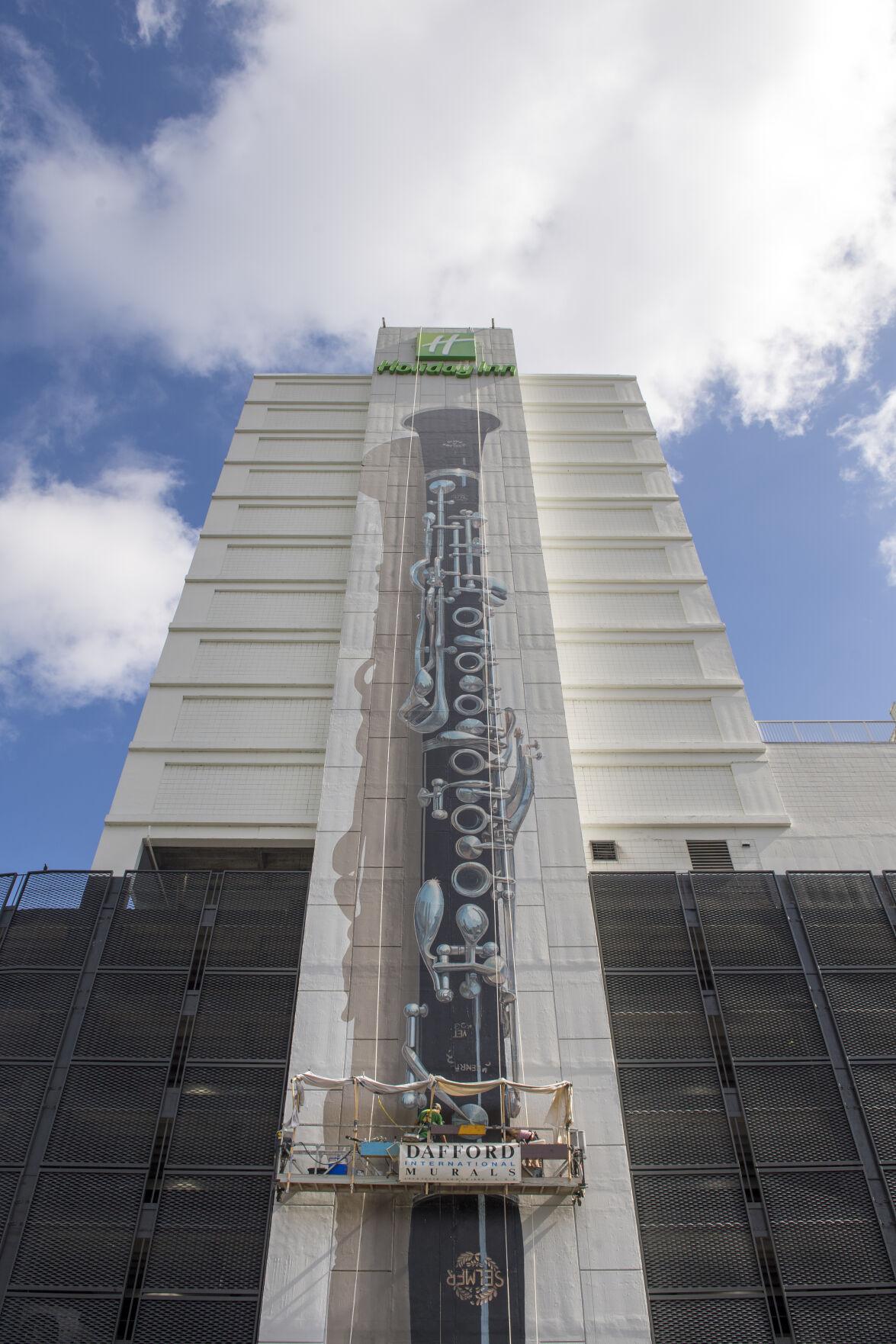
Artists Miguel Lasala and Ellen Ogden stand on a lift alongside the 150-foot tall clarinet on the side of the Holiday Inn New Orleans-Downtown. On Thursday, September 3, 2020 the two of them were touching up and cleaning the painting originally created by Lafayette artist Robert Dafford about 25 years ago. The clarinet is based on the one owned by Sidney Bechet.

1938, JP Jazz Archive
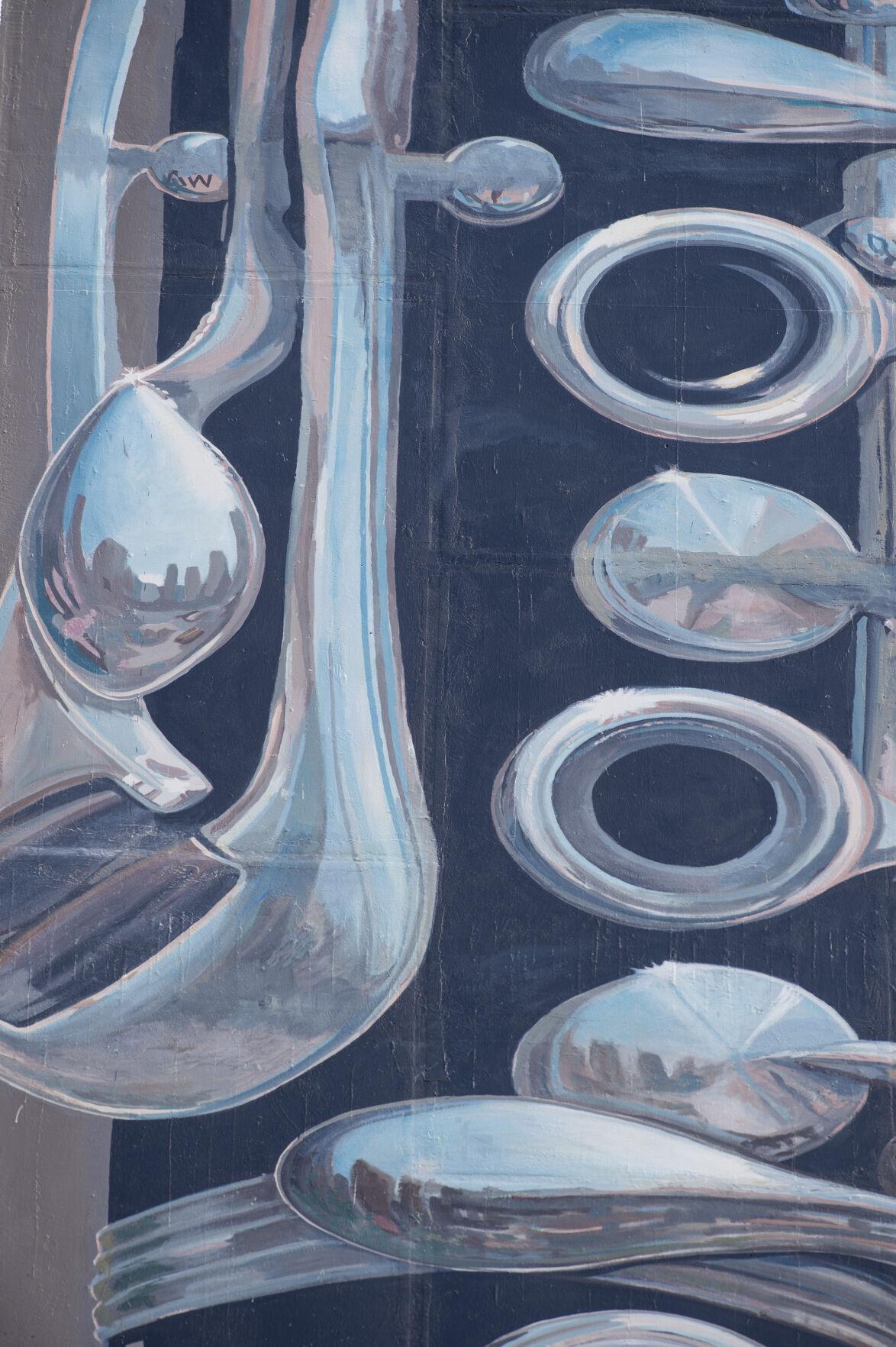
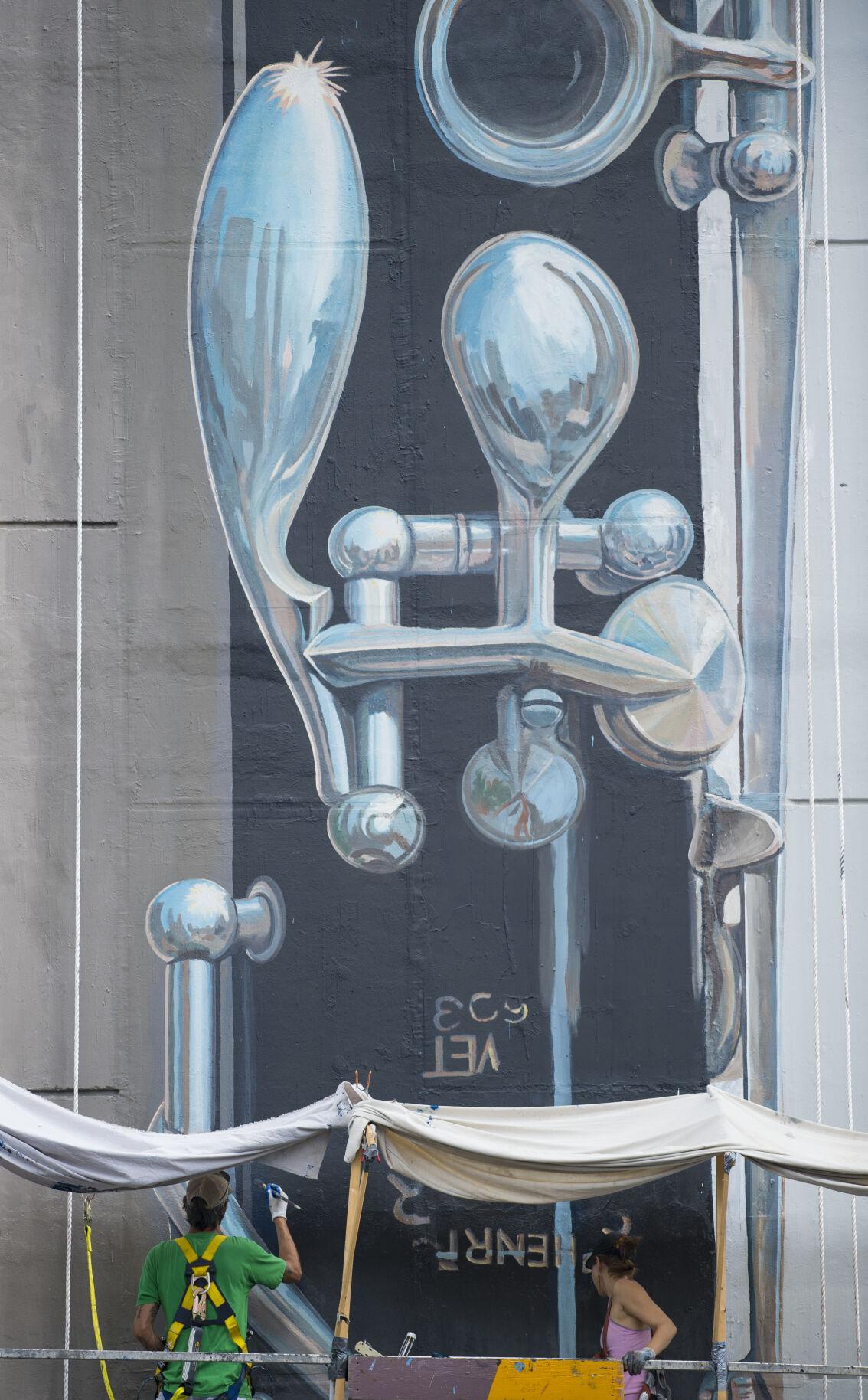
1937
Nick Dellow a écrit:Here is a master test pressing of take 2 of "Characteristic Blues" by Noble Sissle's Swingsters, featuring the glorious clarinet playing of Sidney Bechet. This take was never issued as a master pressing on 78, though it was issued as a dub on the French Swing label.
NOBLE SISSLE'S SWINGSTERS
Sidney Bechet - clarinet / Jimmy Miller - guitar / Jimmy Jones - string bass / Wilbert Kirk - drums / Billy Banks - vocals.
Recorded in New York on April 16, 1937.
Sidney's solo after Billy Banks' vocal is something of a 'set piece' - rather like the famous clarinet solo on "High Society" - and so the variations between the issued take (take 1) and the unissued take 2 are understandably slight, though Bechet always plays with passion regardless of whether the solo pouring out of his clarinet is set or improvised. There are several more noticeable variations earlier on in the recording, both in Bechet's clarinet playing and Billy Banks' words of encouragement!
This master pressing was made by Columbia after WWII, I'm fairly sure at the behest of producer George Avakian, probably so that it could be used for an LP transfer. The issued take was released on the Variety and Vocalion labels in 1937 as part of a group of recordings featuring Bechet that were produced under the auspices of Noble Sissle, the bandleader that Bechet worked for at the time (and for many years before, on and off). These recordings helped to revive interest in Sidney Bechet's playing across the globe, and to finally give him the recognition for his abilities as a leading jazz musician that he so richly deserved. However, it would be over another decade before he could reap the benefits of worldwide fame, and the seeds would be sown in France, not in the country of his birth.
Invité- Invité
 Re: célébrations de la clarinette
Re: célébrations de la clarinette
ma lectorate est gâtée, deux post aujourd'hui. Après l'ellingtonien Barney Bigard, un deuxième clarinettiste entre New-Orleans et Mainstream Swing avait mes faveurs, pour ses débuts chez Fletcher Henderson mais surtout pour ce combo de la fin des années 30 qui réunissait le gratin des virtuoses d'avant le be-bop, emmené par le contrebassite John KirbyWILLIAM "BUSTER BAILEY"
1902-1967
à 1:58, une note tenue 50 secondes en respiration continue (circulaire)
on peut laisser la vidéo remonter le temps avec pour commencer Man With A Horn Goes Berserk en 1938. Perso j'en oublie volontiers tous les Benny Goodman et autres Artie Shaw... Goodman considérait alors Bailey comme le plus grand clarinettiste vivant...Clarinet Marmelade
film 1958
je reviendrai après cette mise en bouche... sans prise de bec
Invité- Invité
 Re: célébrations de la clarinette
Re: célébrations de la clarinette
Peter Openshaw's "A Touch of Blue" arranged for two clarinets and bass clarinet.
Played by Margaret Archibald.
Peter Openshaw a écrit:I composed this originally for clarinet and two saxophones for a concert at a venue more associated with jazz than classical music, so although I am a classical composer, I decided to make the 12-bar blues a starting point from which to take off in surprising directions. In the event, the concert was cancelled, and as I could see no prospect of getting the original line-up again, I arranged the piece for 2 clarinets and bass clarinet, and in fact, it sounds just as good on those instruments.
I am really grateful to Margaret Archibald for a stylish performance on all three instruments which reaches exactly the right balance between jazz and classical idioms. This was all assembled during lockdown with the aid of a click-track. Many thanks too to Robert Archibald, our sound engineer.
bien écrit et interprété. Peu d'improvisation pour se revendiquer du jazz ou de l'esprit du blues. M'enfin, chacun les siens...
Invité- Invité
 Re: célébrations de la clarinette
Re: célébrations de la clarinette
un grand maître de la clarinette disparaît
Turkish clarinet legend Kandıralı dies at 90
Hürriyet Daly News, December 29 2020

Mustafa Kandirali, Sydney Bechet de l’Orient
Maximilien Friche, Mauvaise nouvelle, 22 septembre 2013
La question n’est pas de savoir qui connaît Mustafa Kandirali, cela reviendrait à s’enorgueillir facilement de la grâce de faire partie de ce petit groupe d’élus. La question plus juste pourrait être pourquoi ce musicien essentiel n’est pas plus écouté en Occident, mais l’urgence revient surtout à le faire connaître, à le faire écouter. Il faut bien que la chair vibre pour manifester l'immortalité de l'âme. On peut en causer, mais il faut aussi vous donner le goût de vous laisser enjazzer par ce souffle chargé de sel et de sable, chargé des siècles de civilisation méditerranéenne.
L'homme qui remplit les stades
Mustafa Kandirali est né en 1930 à Izmit Kandıra Crash en Turquie. Il est impossible de visiter aujourd'hui ce pays sans l'entendre à la télévision, dans les rues, dans les taxis ou à la radio. Il incarne dans son souffle cet élastique culturel entre l'orient et l'occident typique de l'identité turque. Il a été surnommé le "Benny Goodman du Proche-Orient" du fait de son swing. À Istanbul, après avoir assisté à un de ses concerts, Louis Armstrong avait d'ailleurs invité Kandirali à une jam session. Il fut de ce fait un des rares orientaux à tourner dans les années 60 aux États-Unis. Que ce clarinettiste soliste remplisse les stades de football ne devrait pas nous surprendre et pourtant nos radios de jazz, nos festivals, de Marciac à Vienne, et nos rayons de disques à la Fnac, sont désespérément vides de ce son qui vibre avec force et âme. "Ce n'est qu'une question de temps avant que son statut de génie de la musique du XXème siècle soit universellement reconnu." concluait avec espoir Mark Hudson, dans le Daily Telegraph 1. Pour l’enregistrement Caz Roman, il est accompagné des meilleurs solistes au canun, cithare trapézoïde, aux darbukas, aux bongos et au luth.
Un swing de la Méditerranée.
Nous pourrions résumer sa façon de souffler dans sa clarinette avec les adjectifs relatifs à un jazz classique, au rythme et à l’enchevêtrement des séquences de style quasi New Orleans. Cependant, il y a dans le vibrato qui accompagne ce swing une âme saturée par la lumière de la méditerranée. L'entendre, c'est systématiquement avoir la sensation de se réveiller pour se rendre à une fête en matinée. Il y a une approche quasi ludique dans la composition des différents éléments musicaux populaires, classiques, issus de la danse du ventre, et bien sûr, du jazz,… Il ne serait pas surprenant que sa virtuosité nous emmène jusqu'à l'extase !
La couleur de ce jazz est clairement issue d’un blues nouveau. Il ne s’agit pas d’un peuple d’esclaves qui prie et se plaint en psaumes chargés de comptes à régler. Il s’agit davantage d’une nostalgie permanente du cœur de la civilisation. Une nostalgie de centre du monde. Il y a des vagues dans la musique de Kandirali, et c’est lui qui souffle pour les créer. Cette musique inspire au surf, il nous pose sur le son et nous envoie vite au loin dans un speed grisant, avant de venir nous rejoindre pour jouer à nouveau avec nous. Et le boum boum se croit dans un grand-huit, jouissant d’être mis à l’épreuve et toujours raccompagné par un geste phonique en surabondance du musicien.
L’élévation du son
Kandirali a une façon d’insister sur un son propre au jazz, mais il va jusqu'à le servir au risque de perdre le souffle. Peut-être la vie. Du moins, on peut y croire. Tant qu’il reste de l’air, il faut le donner. Il agit comme pour une élévation interminable, qui seule peut remettre l’âme humaine en question au regard de ce qui lui est offert. Ce que ce Sydney Bechet de bazar nous offre est une liturgie festive pour célébrer l’élément qui permet la musique : le son. Son vibrato qui se dandine ressemble à cette main trop consciente de son rôle et qui tremble un peu en élevant le Verbe au dessus de sa tête. Le silence est court, la pause infime, il relève le bec aussitôt pour célébrer dans la joie avec tous, la performance passée. Les chapiteaux de Marciac et d’ailleurs ne se seront toujours pas ouverts à la Méditerranée en 2013, pas ouverts à l’origine du souffle. Préférant s’ouvrir à la variété vieillissante comme celle de Joe Cooker. Préférant inviter toujours les mêmes avant qu’ils ne meurent. Aller se produire à Marciac, c’est avoir la quasi certitude de se voir rendre un hommage sous 5 ans. Kandirali est vieux, mais d'un monde ancestral. Nous avons encore à hériter de lui. Nous avons encore à nous relier à la lumière et au sel.
comme on le voit sur les images, il jouait d'une clarinette en sol, en métal, qu'on appelle aussi clarinette des Balkans
Invité- Invité
 Re: célébrations de la clarinette
Re: célébrations de la clarinette
APPÂTS DE BILL SMITH
« J’aime parler les deux langues.
Je pense qu’avoir l’esprit du jazz dans les choses classiques est bon,
et que le jazz bien construit comme la musique classique est sain. »
William Overton Smith (September 22, 1926 – February 29, 2020)[1] was an American clarinetist and composer. He worked extensively in modern classical music, Third Stream and jazz, and was perhaps best known for having played with pianist Dave Brubeck intermittently from the 1940s to the early 2000s.
[...]
Smith investigated and cataloged a wide range of extended techniques on the clarinet, including the use of two clarinets simultaneously by a single performer, inspired by images of the ancient aulos encountered during a trip to Greece, numerous multiphonics, playing the instrument with a cork in the bell, and the "clar-flute," a technique that involves removing the instrument's mouthpiece and playing it as an end-blown flute. As William O. Smith, he wrote several pioneering pieces that feature many of these techniques, including Duo for Flute and Clarinet (1961) and Variants for Solo Clarinet (1963). In an article titled "Contemporary Clarinet Sonorities" (Selmer Bandwagon no. 67, fall 1972, pp. 12–14), Smith compiled the first comprehensive catalogue of fingerings for clarinet multiphonics. He was among the early composers interested in electronic music, and as a performer he continued to experiment with amplified clarinet and electronic delays. He remained active nationally, internationally, and on the local Seattle music scene until well into his 90s. In 2008, he composed, recorded, and premiered a "jazzopera" (his preferred term) titled Space in the Heart.
source
Bill Smith, clarinet, electric clarinet; Enrico Pieranunzi, piano.
Rome, September 17, 1977
1957
Vibraphone – Red Norvo
Clarinet – Bill Smith
Flute – Buddy Collette
Guitar – Barney Kessel
Bass – Red Mitchell
Drums – Shelly Manne
Paying The Dues Blues
Poeme
Divertimento, 1st Movement
2nd Movement
3rd Movement
4th Movement
Smith lived in Paris from 1951 to 1953 as a recipient of the Prix de Paris. Upon his return to the West Coast in 1953, he taught, and performed his Concerto for Clarinet and Combo with Shelly Manne’s group, his Divertimento with Red Norvo’s ensemble and two albums of his "non-jazz" compostions. In 1957 he was awarded the Prix de Rome and in 1960 two Guggenheim Fellowships, which allowed him to devote his time to composition in Rome. There he formed the American Jazz Ensemble with John Eaton, which made two record albums and toured extensively.
vidéo ajoutée
source : Two Sides of Bill Smith
Four Duets for Four Demi-Clarinets by William O. Smith
Mysterious
Angry
Dramatic
Bold
Joshua Gardner & Robert Spring
en compagnie de Jim Hall, très proche de Jimmy Giuffre
mais plus technique
1959
Bill Smith(cl) Jim Hall(g) Monty Budwig(b) Shelly Manne(ds)
Invité- Invité
 Sujets similaires
Sujets similaires» célébrations du SWING
» célébrations lentes
» célébrations du BLUES
» célébrations acoustiques
» célébrations électriques
» célébrations lentes
» célébrations du BLUES
» célébrations acoustiques
» célébrations électriques
Page 1 sur 1
Permission de ce forum:
Vous ne pouvez pas répondre aux sujets dans ce forum
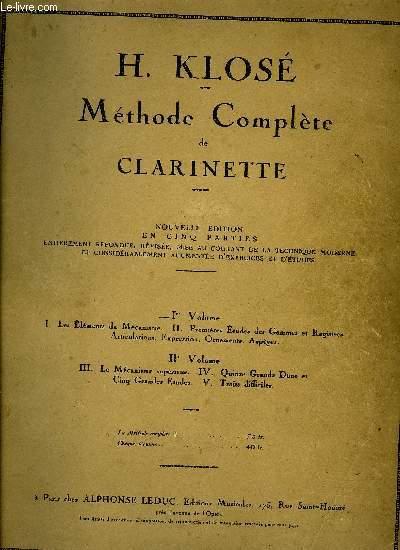





:format(jpeg):mode_rgb():quality(90)/discogs-images/R-10497594-1498666930-6202.jpeg.jpg)
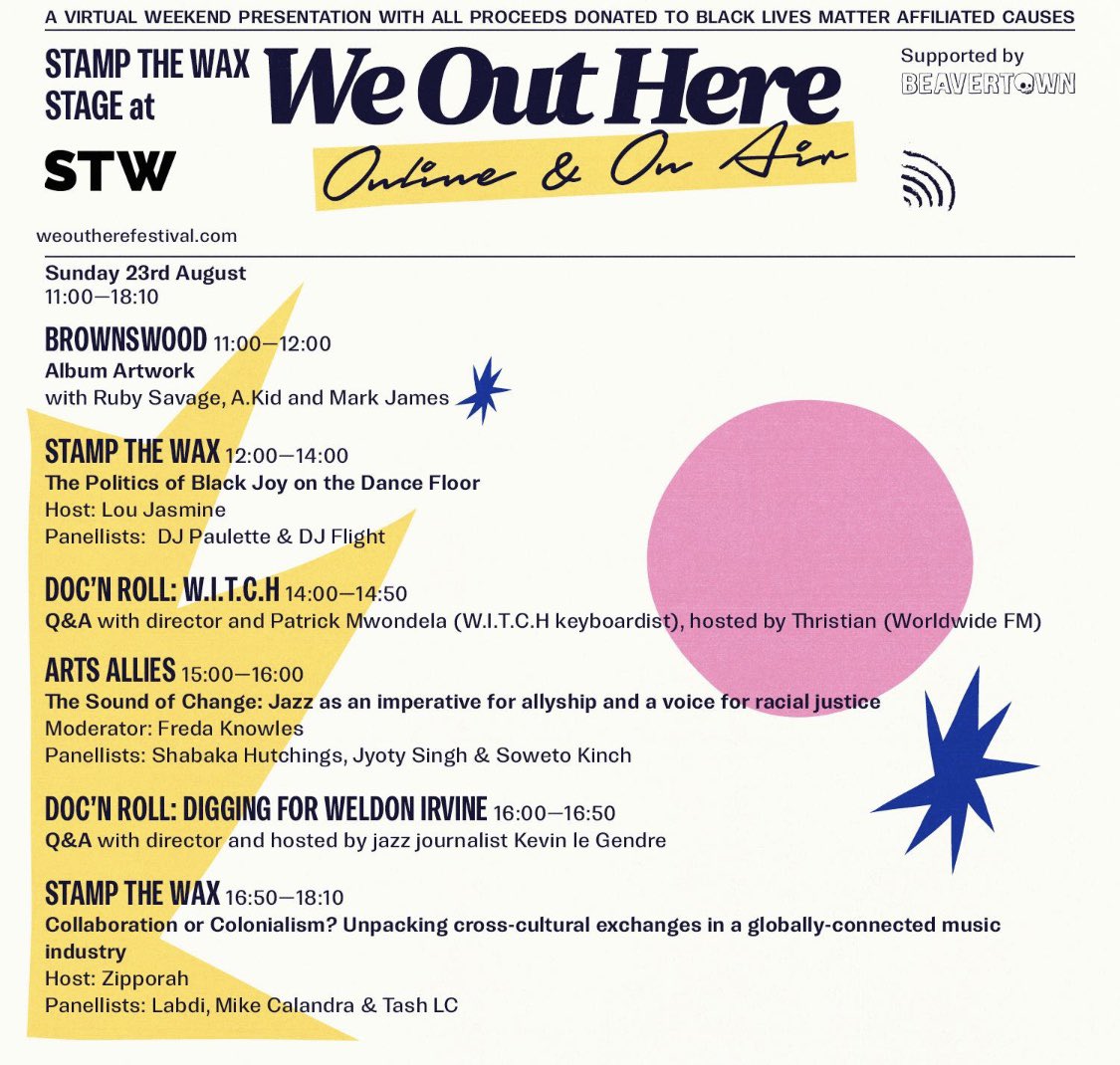


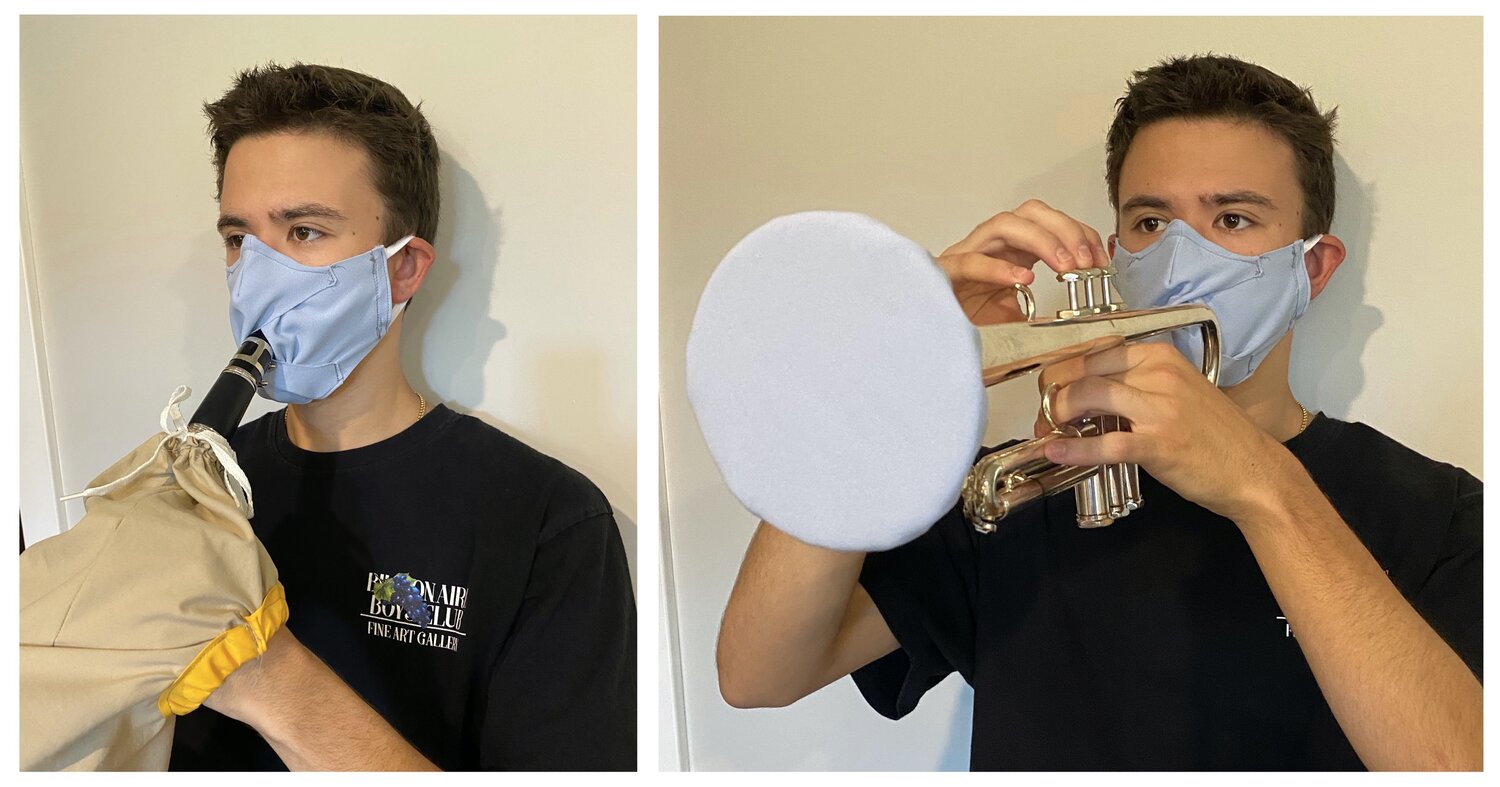
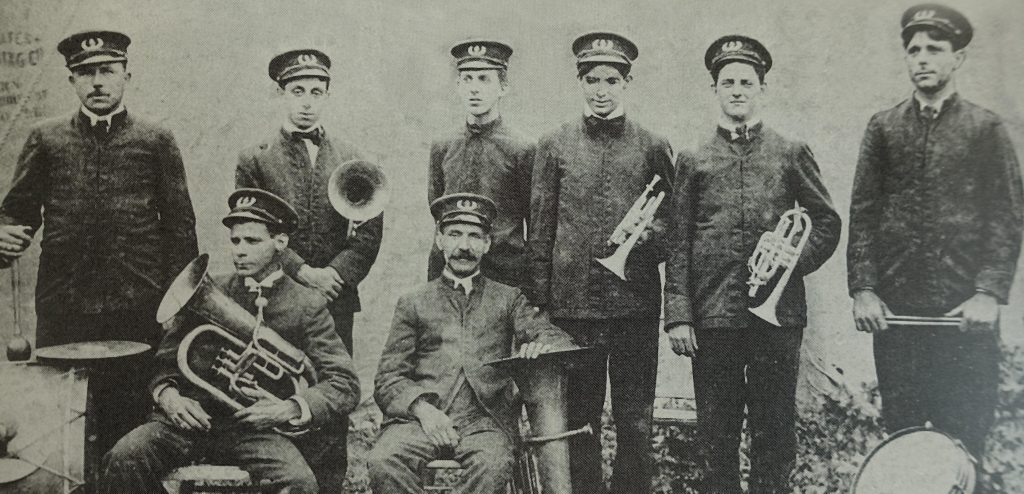
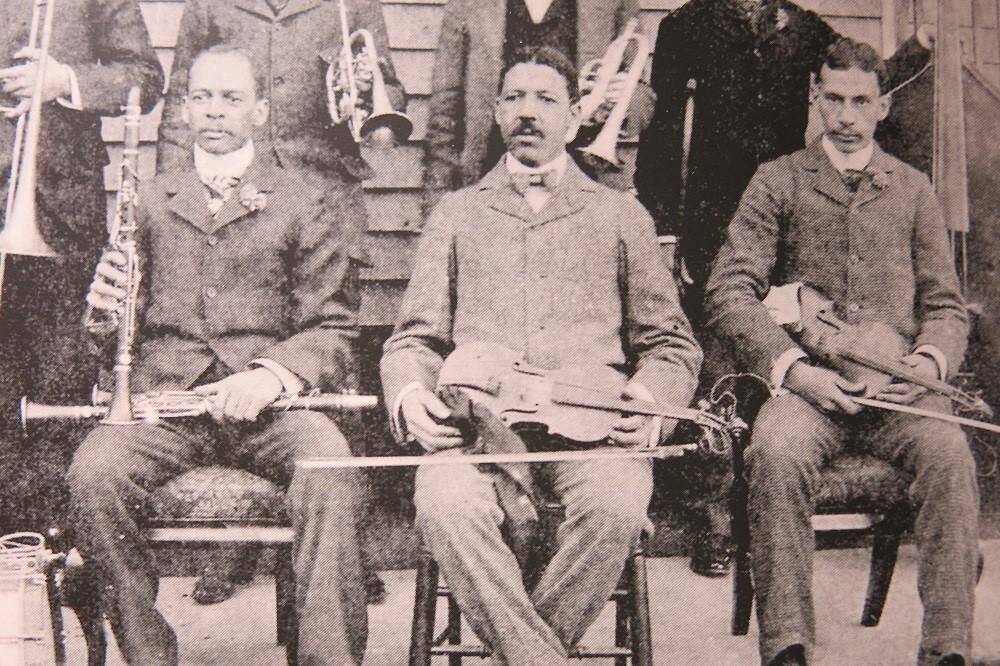
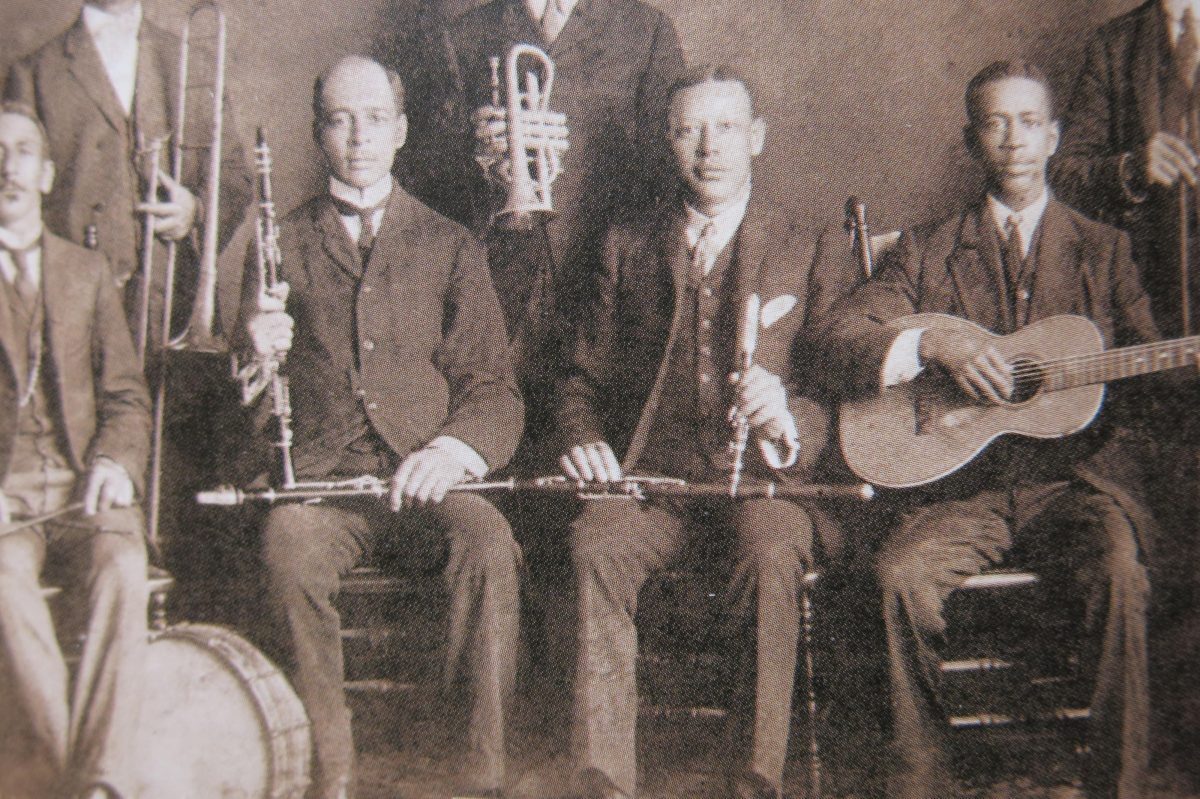

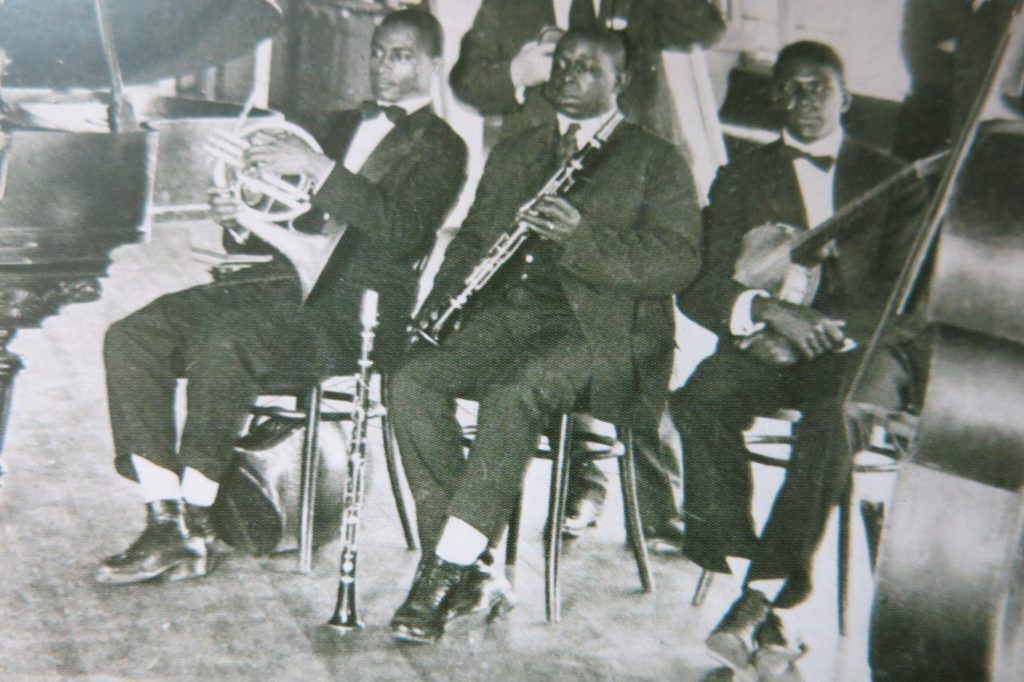


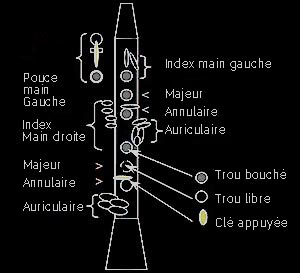
» BIEN CREUSÉ, VIEUX TOP ! Histoires d'une mare
» IRONÈMES, poésie minimaliste, depuis 2018
» MATIÈRES À PENSER
» CRITIQUE DE L'UTOPIE, DES UTOPIES, communistes ou non
» I 2. TECHNIQUES et MUSIQUES pour guitares 6, 7 et 8 cordes, IMPRO etc.
» ET MAINTENANT, LA POLITIQUE RESTRUCTURÉE EN MARCHE
» PETITES HISTWEETOIRES IMPRÉVISÉES
» HOMONÈMES, du même au pas pareil
» LA PAROLE EST À LA DÉFONCE
» KARL MARX : BONNES FEUILLES... BONNES LECTURES ?
» IV. COMBINATOIRE et PERMUTATIONS (tous instruments)
» CLOWNS et CLONES des ARRIÈRE- et AVANT-GARDES
» VI. À LA RECHERCHE DU SON PERDU, ingrédients
» CAMATTE ET MOI
» III. LA BASSE et LES BASSES À LA GUITARE 8 CORDES
» L'ACHRONIQUE À CÔTÉ
» LA CRISE QUI VIENT
» MUSIQUE et RAPPORTS SOCIAUX
» PETITE PHILOSOPHIE PAR LA GUITARE à l'usage de toutes générations, classes, races, sexes...